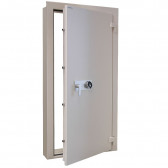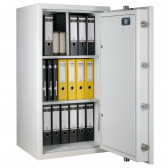Convenient and secure – biometric locks in safes. This is a method that not only provides an exceptionally high level of security, but is also extremely convenient for everyday use. All you have to do is put your finger in the safe to open the lock. How could it be simpler?
How does a biometric lock on a safe work?
Biometrics is a method of automatically recognising people based on their physical characteristics. It uses those characteristics that are individual, unique and unrepeatable – such as the sound of a voice, the minutiae in a fingerprint or the pattern of blood vessels in the retina. The biometric lock has a stored biometric sample set as a pattern to which the data collected when attempting to open the safe is compared. If the system determines that the pattern and the data just collected match, the safe is opened. If there is a discrepancy between the pattern and the data, it will remain closed.
Biometric locks are increasingly used in various types of safes, both in office safes and home safes. In office safes, biometric locks can be particularly useful, providing quick and secure access to documents, valuables or money for authorised persons. For home safes, biometric locks provide effective protection for personal treasures, valuable documents and other valuables stored at home. Thanks to biometric technology, this form of security provides convenience of use and a high level of security, eliminating the need to carry keys or remember access codes.
Read also: How does a safe lock with a fingerprint reader work?
How secure is biometrics as a security method?
Biometric locks are among the most secure locks in safes – firstly because a biometric key is much harder to forge than a code or mechanical key, secondly because it is impossible to lose or forget what opens the biometric lock, and thirdly because it is a password for life. Depending on the technology used and the class of security, biometrics also provides such a high level of security that you can be sure that the chances of the other person having similar fingerprints or iris patterns are virtually nonexistent. It is generally accepted that in mid-range biometric security it is acceptable to successfully authenticate a stranger once every 10,000 scans.
At the same time, it should be remembered that biometric locks, unlike electronic (code) locks, are based on data comparison and probability (so-called pattern matching). They are not – like a code – a "zero-one" system (either the code is correct or it is not). (either the code is correct or it is not). This can cause difficulties in correctly identifying the owner of a safe. For example, in a lock based on a biometric lock with voice recognition, a simple runny nose can result in the owner having difficulty opening the lock. In mid-range biometric locks, it is considered that a mistake against the owner of the scan may happen once in 50 scans (in this case, however, we simply scan ourselves a second time).
Which biometric locks can be used in safes?
The most commonly used solution in safes is fingerprint biometrics (based on a fingerprint). This is also the most convenient biometric lock (safe installation height, angle, lighting, temperature conditions, etc. do not matter). Increasingly, iris or retina scans are also used in safes (note: these are two different methods, although both are based on eye biometrics). Unfortunately, this method has an important limitation (which can also be considered an advantage) – the scanner must be mounted at eye level. Voice recognition and face scanning can also be used. Both of these methods, however, due to possible verification errors (lack of proper voice or face recognition) are used more often as supplementary methods to the standard key or code.
It may interest you: Which lock to choose for safes?
How to open a safe equipped with a mechanical and electronic lock?





